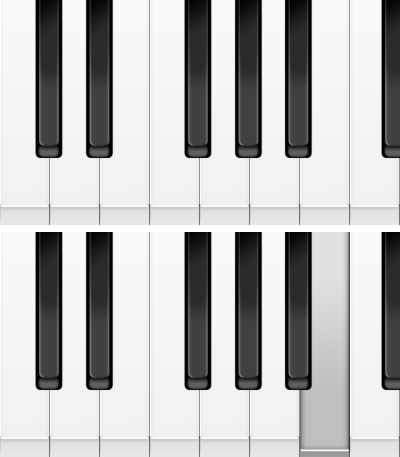Task: Piano
This task, based on the Piano sample delivered with the Tizen SDK, demonstrates how you can use the HTML5 audio element API to create a piano application and play sounds. For more information on the sample functionality and creating the sample with the full source code, see Piano.
This task consists of the following parts:
- Defining the Application Layout defines how to create the application screens.
- Initializing the Application defines how to initialize the application.
- Handling the Keys defines how to create the piano object.
- Playing Sounds defines how to use the audio element to play sounds.
This sample is a fully functional application for playing a piano. The user can use multi-touch to play a combination of sounds from a single octave.
Defining the Application Layout
The Piano sample application layout contains only 1 screen: the main screen that displays the piano keyboard.
The following figure shows the main screen of the application.
Figure: Piano screen

Defining the Main Screen
- index.html Source File
The main screen displays a piano keyboard. The keys are defined as <div> elements whose class attribute is set to button.
<body ondragstart="return false" onselectstart="return false"> <div class="button white_btn" id="play0"></div> <div class="button white_btn" id="play2"></div> <div class="button white_btn" id="play4"></div> <div class="button white_btn" id="play5"></div> <div class="button white_btn" id="play7"></div> <div class="button white_btn" id="play9"></div> <div class="button white_btn" id="play11"></div> <div class="button white_btn" id="play12"></div> <div class="button black_btn" style="left: 8.6%" id="play1"></div> <div class="button black_btn" style="left: 21.2%" id="play3"></div> <div class="button black_btn" style="left: 45.8%" id="play6"></div> <div class="button black_btn" style="left: 58.4%" id="play8"></div> <div class="button black_btn" style="left: 70.9%" id="play10"></div> <div class="button black_btn" style="left: 95%" id="play13"></div> </body>
- style.css Source File
The appearance of the key buttons is defined in the CSS file.
.white_btn { background: url('../white.png') bottom center no-repeat transparent; height: 100%; display: inline-block; background-size: 100%; width: 12.5%; height: 100%; position: relative; float: left; margin: 0; padding: 0; display: block; margin: 0; } .white_btn.pressed { background-image: url('../white_pressed.png'); } .black_btn { float: left; background: url('../black.png') bottom center no-repeat transparent; width: 7.6%; height: 73.8%; background-size: 100%; background-position: top center; position: fixed; top: 0px; } .black_btn.pressed { background-image: url('../black_pressed.png'); }
Initializing the Application
- main.js Source File
-
The piano variable is declared to create the Piano object. A keyword is determined for optimizing browser performance and validating JavaScript. Elements are defined for storing the piano key element object IDs and corresponding audio elements.
var piano; function Piano() { "use strict"; } function() { "use strict"; Piano.prototype = { touchPianoKey: [], lockIds: {}, audio: [], whiteCache: null, blackCache: null } }; -
The audioInit() method is used to create and initialize the audio element for each keyboard button. The element contains an event listener to detect button events.
Piano.prototype.audioInit = function audioInit() { var i, self = this; for (i = 0; i <= 13; i += 1) { this.audio[i] = document.createElement('audio'); this.audio[i].name = i; this.audio[i].src = this.audio[i].name + ".wav"; this.audio[i].addEventListener("playing", function() { self.lockIds["play" + this.name] = false; }); } };
-
Handling the Keys
The event handling functionality is implemented in the main.js file.
- Creating Event Listeners
-
The onPianoKeyTouchDown() event listener is created to detect the touch event, when the user presses a piano key.
Piano.prototype.onPianoKeyTouchDown = function onPianoKeyTouchDown(data) { data.originalEvent.preventDefault(); var element, touch, i, len; for (i = 0, len = data.originalEvent.changedTouches.length; i < len; i += 1) { touch = data.originalEvent.changedTouches[i]; element = document.elementFromPoint(touch.clientX, touch.clientY); if (element) { if (this.touchPianoKey[touch.identifier] !== element.id) { $('#' + this.touchPianoKey[touch.identifier]).removeClass('pressed'); this.playAudioByElement(element, touch.identifier, function() { this.lockIds[element.id] = true; }); } } } }; -
The onPianoKeyTouchUp() event listener is created to detect the touch event, when the user releases a piano key.
Piano.prototype.onPianoKeyTouchUp = function onPianoKeyTouchUp(data) { var i, touchId, len, buttonId; for (i = 0, len = data.originalEvent.changedTouches.length; i < len; i += 1) { /* Get the number assigned to the finger touching the screen */ touchId = data.originalEvent.changedTouches[i].identifier; buttonId = this.touchPianoKey[touchId]; setTimeout(function() { (function(id) { $('#' + id).removeClass('pressed'); }) (buttonId); }, 100); this.touchPianoKey[touchId] = undefined; } };
-
- Binding Events
The bindEvents() method is used to register event handlers to the corresponding events.
Piano.prototype.bindEvents = function bindEvents() { var self = this; $(".button").bind('touchstart touchmove', function(e) { self.onPianoKeyTouchDown(e); }); $(".button").bind('touchend', function(e) { self.onPianoKeyTouchUp(e); }); $('#back').bind('touchstart', function(event) { event.preventDefault(); event.stopPropagation(); /* Apply CSS style dynamically */ $(this).addClass('active'); tizen.application.getCurrentApplication().exit(); }); $('#back').bind('touchend', function(event) { /* Cancel the applied CSS style */ $(this).removeClass('active'); }); document.addEventListener('webkitvisibilitychange', function() { if (document.webkitVisibilityState === 'visible') { self.audioInit() } }) };
Playing Sounds
This section builds upon the elements described in Playing Media Files.
- main.js Source File
The playAudioByElement() method is used to play the sound determined in the audio element, when a given key button is pressed.
Piano.prototype.playAudioByElement = function playAudioByElement(element, touchId, callback) { var audio = this.audio[element.id.substr(4)]; $(element).addClass('pressed'); this.touchPianoKey[touchId] = element.id; if (audio) { if (audio.paused) { audio.play(); } if (audio.currentTime !== 0) { audio.currentTime = 0; } if (callback instanceof Function) { callback.call(this); } } };

